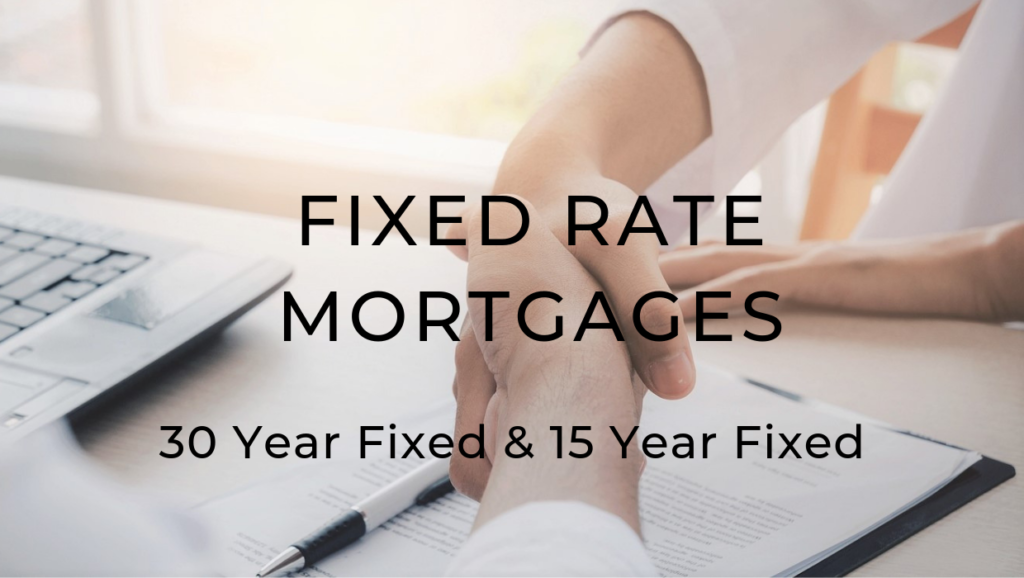
A fixed rate mortgage is one of the most common choices, when it comes to mortgage financing. The primary advantage with a fixed rate mortgage is knowing that your interest rate and monthly principal and interest payment will always remain the same. Fixed rate loans are fully amortized loans, which means that if all the mortgage payments are made according to the amortization schedule, the loan will be fully paid off by the end of the loan term.
The most common types of fixed rate loans are the 30 Year Fixed and 15 Year Fixed. Let’s take a closer look at each one.
30 Year Fixed
Advantages: A 30 Year Fixed loan will offer a lower monthly (principal and interest) payment, compared to a 15 Year Fixed loan because the payments are amortized over a longer period of time (30 years versus 15 years). The lower monthly payment of a 30 Year Fixed loan allows homeowners the ability to optimize their cash-flow and to qualify for higher loan amounts than they would be able to, with a 15 year fixed loan. Homeowners choosing a 30 year fixed also have the flexibility to make additional payments to pay off the loan sooner.
Disadvantages: The interest rate on a 30 Year Fixed Loan will be higher than the rate on a 15 Year Fixed loan. Homeowners will pay significantly more in mortgage interest over the life of the loan.
15 Year Fixed
Advantages: A 15 Year Fixed will have a lower interest rate than a 30 Year Fixed loan. It is a great loan choice for homeowners who would like to pay off their mortgages in a shorter period of time, like those approaching retirement. With a 15 Year Fixed, homeowners will pay less mortgage interest over the life of the loan, due to the lower interest rate and shorter amortization period.
Disadvantages: The monthly principal and interest payment on a 15 Year Fixed loan will be higher than a 30 Year Fixed loan, because the 15 Year Fixed loan is amortized over a shorter period of time. The higher payment offer less cash-flow flexibility. The higher payment on a 15 Year Fixed loan may also prevent homeowner from qualifying for a larger loan amounts.
Example: Monthly Payment and Mortgage Interest Comparison
For this example, we’ll compare a 30 Year Fixed loan and a 15 Year Fixed loan of $300,000.00, to determine the difference in monthly payment and the amount of mortgage interest, paid over the life of the loan:
30 Year Fixed – Loan Amount: $300,000.00 – Interest Rate: 3.750%
Monthly Principal and Interest Payment: $1,389.35
Total Mortgage Interest paid over the 30 year loan term: $200,164
15 Year Fixed – Loan Amoumt: $300,000.00 – Interest Rate 3.250%
Monthly Principal and Interest Payment: $2,108.01
Total Mortgage Interest paid over the 15 year loan term: $79,441
As you can see, the monthly principal and interest payment on a 15 Year Fixed loan is approx. 50% higher than the monthly payment of a 30 Year Fixed loan. However the total mortgage interest paid over the life of the loan on a 30 Year Fixed loan is nearly 2.5 times higher than that of a 15 Year Fixed loan.
Example – Qualifying Differences
For this example, we’ll take at the same monthly principal and interest payment of $2,000, and determine how much of a loan amount a homeowner can qualify for, with a 30 Year Fixed and 15 Year Fixed.
30 Year Fixed at 3.750% – Monthly Principal and Interest Payment: $2,000.00
Loan Amount: $432,000.00
15 Year Fixed at 3.250% – Monthly Principal and Interest Payment: $2,000.00
Loan Amount: $284,500.00
You’ll notice that a 30 Year Fixed loan allows a homeowner to borrow nearly 50% more in loan amount, with the same monthly payment, compared to a 15 Year Fixed loan.
Are you considering a 30 Year Fixed or 15 Year Fixed mortgage? Please feel free to contact me so we can review your financing options, and decide which fixed rate loan is best for you.
